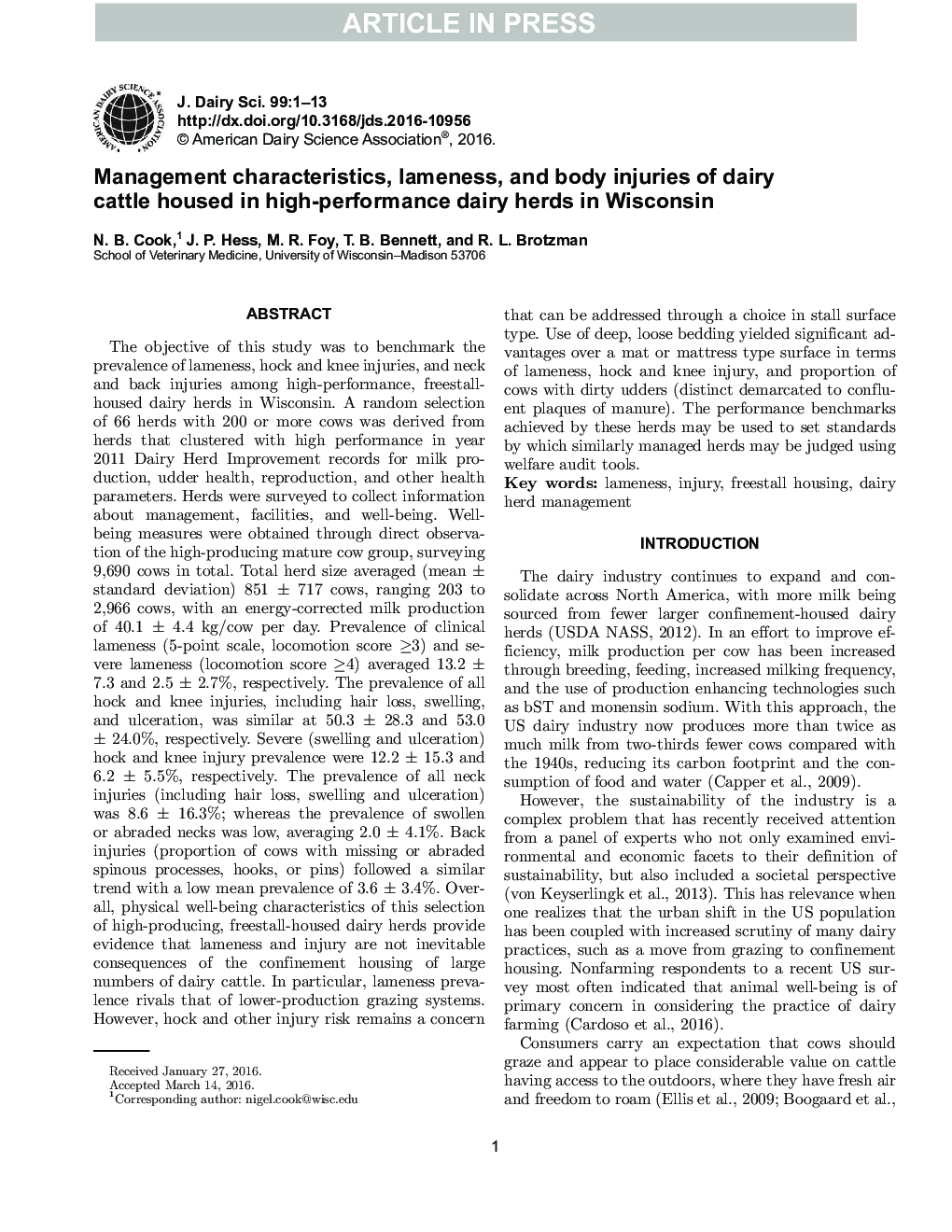| کد مقاله | کد نشریه | سال انتشار | مقاله انگلیسی | نسخه تمام متن |
|---|---|---|---|---|
| 10973684 | 1108017 | 2016 | 13 صفحه PDF | دانلود رایگان |
عنوان انگلیسی مقاله ISI
Management characteristics, lameness, and body injuries of dairy cattle housed in high-performance dairy herds in Wisconsin
ترجمه فارسی عنوان
ویژگی های مدیریتی، لنگش و آسیب های بدن گاوهای شیری در گله های شیری با عملکرد بالا در ویسکانسین
دانلود مقاله + سفارش ترجمه
دانلود مقاله ISI انگلیسی
رایگان برای ایرانیان
کلمات کلیدی
لنگش صدمه، مسکن آزاد مدیریت گله شیری،
موضوعات مرتبط
علوم زیستی و بیوفناوری
علوم کشاورزی و بیولوژیک
علوم دامی و جانورشناسی
چکیده انگلیسی
The objective of this study was to benchmark the prevalence of lameness, hock and knee injuries, and neck and back injuries among high-performance, freestall-housed dairy herds in Wisconsin. A random selection of 66 herds with 200 or more cows was derived from herds that clustered with high performance in year 2011 Dairy Herd Improvement records for milk production, udder health, reproduction, and other health parameters. Herds were surveyed to collect information about management, facilities, and well-being. Well-being measures were obtained through direct observation of the high-producing mature cow group, surveying 9,690 cows in total. Total herd size averaged (mean ± standard deviation) 851 ± 717 cows, ranging 203 to 2,966 cows, with an energy-corrected milk production of 40.1 ± 4.4 kg/cow per day. Prevalence of clinical lameness (5-point scale, locomotion score â¥3) and severe lameness (locomotion score â¥4) averaged 13.2 ± 7.3 and 2.5 ± 2.7%, respectively. The prevalence of all hock and knee injuries, including hair loss, swelling, and ulceration, was similar at 50.3 ± 28.3 and 53.0 ± 24.0%, respectively. Severe (swelling and ulceration) hock and knee injury prevalence were 12.2 ± 15.3 and 6.2 ± 5.5%, respectively. The prevalence of all neck injuries (including hair loss, swelling and ulceration) was 8.6 ± 16.3%; whereas the prevalence of swollen or abraded necks was low, averaging 2.0 ± 4.1%. Back injuries (proportion of cows with missing or abraded spinous processes, hooks, or pins) followed a similar trend with a low mean prevalence of 3.6 ± 3.4%. Overall, physical well-being characteristics of this selection of high-producing, freestall-housed dairy herds provide evidence that lameness and injury are not inevitable consequences of the confinement housing of large numbers of dairy cattle. In particular, lameness prevalence rivals that of lower-production grazing systems. However, hock and other injury risk remains a concern that can be addressed through a choice in stall surface type. Use of deep, loose bedding yielded significant advantages over a mat or mattress type surface in terms of lameness, hock and knee injury, and proportion of cows with dirty udders (distinct demarcated to confluent plaques of manure). The performance benchmarks achieved by these herds may be used to set standards by which similarly managed herds may be judged using welfare audit tools.
ناشر
Database: Elsevier - ScienceDirect (ساینس دایرکت)
Journal: Journal of Dairy Science - Volume 99, Issue 7, July 2016, Pages 5879-5891
Journal: Journal of Dairy Science - Volume 99, Issue 7, July 2016, Pages 5879-5891
نویسندگان
N.B. Cook, J.P. Hess, M.R. Foy, T.B. Bennett, R.L. Brotzman,
